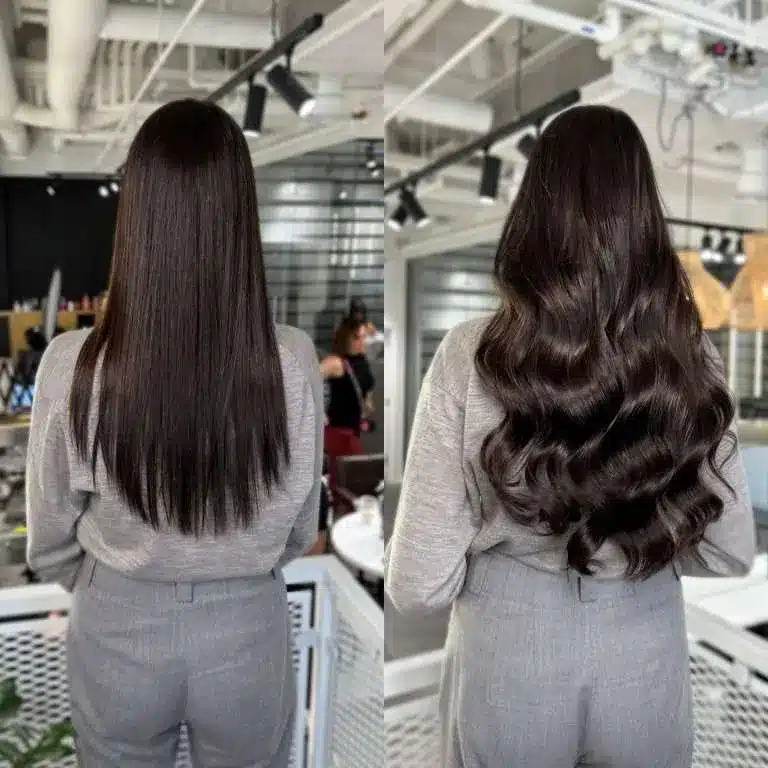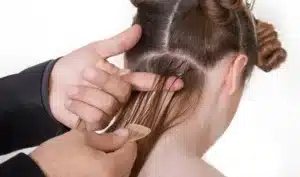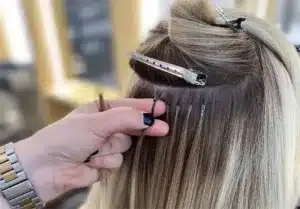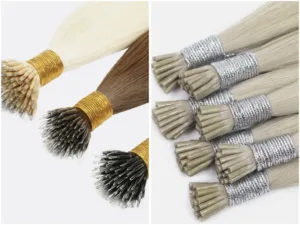You want longer, fuller hair that still looks like your own. You also want a safe choice, a clear price, and simple care.
Hair extensions are worth it when quality, method, and care match your hair and lifestyle. Full cuticle hair and a correct install deliver a natural look, long wear, and reuse. Problems come from cheap materials, heavy mapping, or weak aftercare. Choose well and follow a simple plan.

You will get straight answers here. You will see quick rules, decision tables, and simple steps you can use before you book.
Is hair extension good?
You want a beautiful change with low risk. You also want hair that moves and styles like your own.
Yes. Hair extensions are good when the hair can carry the weight, the method fits your routine, and the aftercare is simple and clear. Full cuticle hair gives the best life and the best look.
Good means natural in the mirror and simple in daily life. Natural means clean lines, soft movement, and color that blends. Tracks should sit flat. There should be no bulky edges. Styling should feel the same as your own hair, with normal brushes and tools. Full cuticle hair helps with all of this. The cuticle stays intact and aligned. Shine is natural, not plastic. Texture holds a curl or a smooth finish longer. Ends keep their shape.
Daily life must be easy. You should wash, dry, brush, and style without stress. The method matters here. Tape-in gives a very flat lay and quick volume. Keratin (U tip) gives strand-by-strand control. A beaded or genius weft row spreads weight across a track and stays slim. Clip-ins and halos are best for events or a no-commitment trial.
A simple one-minute self-check helps you say “yes” with confidence:
| Question | Quick Rule | Why it Matters |
|---|---|---|
| Hair health today? | Fine, medium, or strong? | Sets safe density and method |
| Main goal? | Volume, length, or color pop | Sets grams and placement |
| Lifestyle? | Gym, swim, heat tools | Sets care and method tolerance |
| Time? | Move-ups and daily brushing | Protects comfort and results |
| Budget? | Hair + install + maintenance | Keeps costs clear and calm |
When these points line up, extensions are not only good. They are great. The result looks real, feels light, and fits your routine.
What are the disadvantages of hair extensions?
You want the truth, not a sales pitch. You also want fixes that work.
Disadvantages come from weight, tension, adhesives, and neglect. Risks include slippage, residue, scalp stress, and added salon time. You reduce these with lighter density, patient removal, clean products, and a clear move-up plan.**
Any attachment adds weight. Weight plus tension can stress fragile hair if the plan is wrong. Fine hair cannot support heavy rows at the crown or sides. Oily scalps can loosen tape faster. Very hot tools near bonds can soften tips or tapes. The fix is design and behavior. Choose a lighter plan on fine zones. Keep safe margins from hairline and part lines. Keep direct heat off bonds.
Adhesives can leave residue if they are low grade or if removal is rushed. A good salon uses premium tape and the right solvent. Removal should be patient and gentle. Tapes should be split and cleaned, not peeled. Keratin bonds should be softened with the right remover and broken down fully before sliding off. Beads should be opened and slid, not pulled. Slow is safe.
Matting happens when roots are not brushed and when roots stay wet. A daily root-line brush stops tangles. Roots should be dried first after every wash or workout. Conditioner should stay off the bonds and tapes. These two habits prevent most issues.
Time is a factor. There is a move-up cycle. There are check-ins. If you plan the calendar and follow it, time stays predictable and stress stays low.
| Disadvantage | Typical Cause | Simple Fix |
|---|---|---|
| Slippage | Oil, heavy rows, poor prep | Clarify before install, adjust density, quality tape/beads |
| Residue | Cheap adhesive, rushed removal | Right solvent, patient removal, clean tools |
| Tension | Over-density, tight mapping | Lighter crown/sides, safe margins |
| Matting | No root brushing, wet roots | Daily scalp-line brushing, dry roots first |
Should I get hair extensions?
You want a clear yes or no. You also want a safe way to test before a big step.
Yes, if your hair can handle light tension, your routine allows simple care, and your budget covers hair plus maintenance. Try a partial or a halo if you want a safe test before a full set.
Dive deeper
Start with your goal. Volume uses fewer grams and adds fullness fast. Length needs more grams and careful mapping so the line looks natural. Color pops need very little hair and give impact with low tension. Next, consider your routine. If you work out often, you can still wear extensions. You will need to rinse sweat, dry roots, and brush daily. If you swim a lot, you will need to protect hair in the pool and rinse right away.
Now consider time. Tape-in often needs checks every 6–8 weeks. Beaded or genius weft rows often need 6–10 weeks. Keratin U tip often stays 3–4 months before removal and reinstall. Add these dates to your calendar now. This keeps tension low and comfort high.
If any answer makes you unsure, start small. A halo or clip-ins give the look with zero bonds. A partial row or a few tape panels give a real-world test with low cost. When you love the routine, scale up. This path keeps hair healthy and keeps you happy.
| Goal | Best First Step | Why |
|---|---|---|
| Volume | Tape micro-panels or one slim row | Low tension, quick result |
| Length | Two slim weft rows or keratin strands | Even weight, natural swing |
| Color pops | A few tapes or keratin accents | Small count, safe test |
| Event-only | Clip-ins or halo | No maintenance, fast install |

How to choose the right hair extensions?
You want a simple plan that avoids guesswork. You also want words you can use in a consult.
Match quality → method → mapping. Choose full cuticle hair for longest life and clean shine. Pick method by hair type and lifestyle. Map density by zones with safe margins and a set move-up window.**
Dive deeper
Quality. Hair quality controls lifespan and look. Full cuticle hair keeps the outer shell intact and aligned. It resists tangles, keeps softness, and styles well. With care, it lasts 12–18 months. Regular Remy hair gives about 4–6 months. Non-Remy gives 1–3 months and loses coating fast. If you want the best look with the least fuss, choose full cuticle hair.
Method. Pick the attachment that fits both your hair and your days. Tape-in is thin and fast, great for volume and soft length on medium hair. Keratin U tip is precise strand-by-strand control, great for balancing density or for active clients when mapped right. A beaded or genius weft row spreads weight across a slim track and allows flexible cuts anywhere along the seam. Clip-ins and halos are for events or trial wear.
Mapping. The head has zones: nape, mid, crown, sides. Fine zones need lighter density. Strong zones can support more hair for length. Leave safe margins from hairline and part lines. Stagger bonds so weight does not stack on the same follicles. A good map feels light, looks natural, and grows out clean.
| Factor | Option | Best For | Move-Up |
|---|---|---|---|
| Hair Quality | Full cuticle | Long wear, natural shine | 6–10 week checks |
| Method | Tape-in | Fast volume, flat lay | 6–8 weeks |
| Method | Genius weft row | Seamless rows, flexible cut | 6–10 weeks |
| Method | Keratin U tip | Precision and balance | 3–4 months, then remove |
How much do hair extensions cost?
You want a clear number and no surprises. You also want to see what drives the price.
Cost = hair (grams and length) + install + maintenance. Full cuticle hair costs more and lasts longer. Reuse spreads the hair cost over many months. A simple plan keeps the total fair and clear.**
Dive deeper
Price has two parts. First is hair. The longer the hair and the more grams you need, the higher the price. Full cuticle hair sits at a premium. It also lasts far longer. This changes the math because you can reuse it many times. Second is service. Install time, move-ups, removal, and styling make up the service fees. Region and stylist skill affect these fees.
A clear quote shows hair cost, install, the first move-up window, and expected reuse. It also lists the products to use and avoid. Ask for this plan in writing. Buy an aftercare kit if it is offered. The right brush and gentle wash products protect bonds and reduce salon time later.
| Line Item | What You Pay For | How to Control It |
|---|---|---|
| Hair grams & length | Volume vs. length; 14–24″ | Start with volume; scale up |
| Hair quality | Full cuticle vs. Remy vs. non-Remy | Choose full cuticle for reuse |
| Install | Method and time | Pick a method that fits hair |
| Maintenance | Move-ups and removal | Book on time; follow care |
| Products | Brush, gentle wash, leave-in | Use the kit; avoid harsh oils on bonds |
A full cuticle set reused across several move-ups often lowers the monthly cost compared to cheaper hair replaced often. Reuse is the hidden saver.

How long do hair extensions last?
You want clear numbers you can trust. You also want to separate hair life from move-ups.
Full cuticle hair lasts 1–2 years with proper care. Regular Remy lasts 4–6 months. Non-Remy lasts 1–3 months. Move-ups vary by method from 6 weeks to 4 months.**
Dive deeper
There are two clocks. The first is the life of the hair itself. Full cuticle hair keeps the outer shell. It stays smooth and strong for the longest time. Regular Remy aligns direction but does not protect the cuticle fully. It lasts a medium term. Non-Remy often relies on a coating that washes off. It lasts a short term. If you want a stable look with less fuss, choose full cuticle hair.
The second clock is growth. Your hair grows and moves the attachments away from safe zones. You need to move them up on a schedule. Tape-in often needs 6–8 weeks. Beaded or genius weft rows often need 6–10 weeks. Keratin U tip often needs a removal and reinstall at 3–4 months. These windows keep tension safe and comfort high.
| Quality | Typical Lifespan | Notes |
|---|---|---|
| Full cuticle | 12–24 months | Best reuse and shine |
| Regular Remy | 4–6 months | Medium wear |
| Non-Remy | 1–3 months | Short wear |
| Method | Move-Up / Cycle | Reuse Plan |
|---|---|---|
| Tape-in | 6–8 weeks | Clean, retape, reinstall |
| Genius/Beaded weft | 6–10 weeks | Shift rows; keep weft |
| Keratin U tip | 3–4 months | Remove; re-tip quality hair; reinstall |
Care and maintenance checklist
You want simple rules that protect your hair and your result. You also want fewer salon fixes.
Brush roots daily, dry roots first after washing, and keep oils and heavy conditioners off the bonds. Sleep with a loose braid. Book move-ups on time. These small habits protect everything.
Dive deeper
Keep care short and consistent. Wash 2–3 times per week, or as needed for your scalp. Use a gentle, sulfate-free shampoo on the scalp. Rinse well. Keep conditioner from mid-length to ends. Do not put conditioner on tapes or bonds. After every wash or workout, dry roots first. Do not leave moisture trapped at the attachment points. Brush daily with a loop or soft extension brush. Start at the ends. Work up slowly. Then do a light pass at the scalp line near every row or bond to stop tangles.
Use heat tools with care. A heat protectant helps. Keep irons moving. Keep direct heat off tapes and bonds. For sports, rinse sweat and dry roots right away. For swimming, braid hair and, if possible, use a cap. Rinse chlorine or salt out as soon as you can.
Set your next dates at install. Put them in your phone before you leave the salon. A two-week quick check helps first-time wearers. Call early if anything feels different. Small, fast fixes prevent bigger issues.
| Habit | Why It Helps | Quick Tip |
|---|---|---|
| Dry roots first | Prevents slip and odor | Aim nozzle at rows and bonds |
| Daily root brush | Stops tangles at scalp line | Use a loop brush, gentle pass |
| Keep oils off bonds | Protects adhesive or tips | Apply mid-lengths to ends only |
| Sleep in a loose braid | Reduces friction | Use a silk scrunchie or tie |
My opinion
Extensions are worth it when you choose full cuticle hair, the right method, and a simple care plan. The look stays natural. The hair lasts longer. The monthly cost stays reasonable because you reuse the hair. A safe plan beats a fast one. Start small if needed. Scale up when your routine feels easy.
FAQ
Are extensions safe for thin hair?
Yes, with a light plan. Use fewer grams and gentle mapping. Keep rows slim. Follow the brushing and drying rules.
Do extensions damage hair?
They can if density is too heavy or if move-ups are late. A correct method and on-time maintenance keep tension safe.
Can you color extensions?
Toning and soft changes are possible away from bonds. For big color shifts, remove, color, and reinstall. Full cuticle hair lifts cleaner.
Can you work out with extensions?
Yes. Rinse sweat when you can. Dry roots the same day. Brush the scalp line to prevent tangles.
What is the easiest first step?
Try a halo or clip-ins, or a small partial set. Learn the care, then build to a full plan.
What is the difference between weft hair extensions vs tape in?
Tape-in is thin and fast for volume. Weft rows spread weight and allow flexible cutting. The best choice depends on your hair and goals.
Conclusion
Choose full cuticle hair, a method that fits your life, and simple care. Start light. Keep move-ups on time. Enjoy a natural look that lasts.




